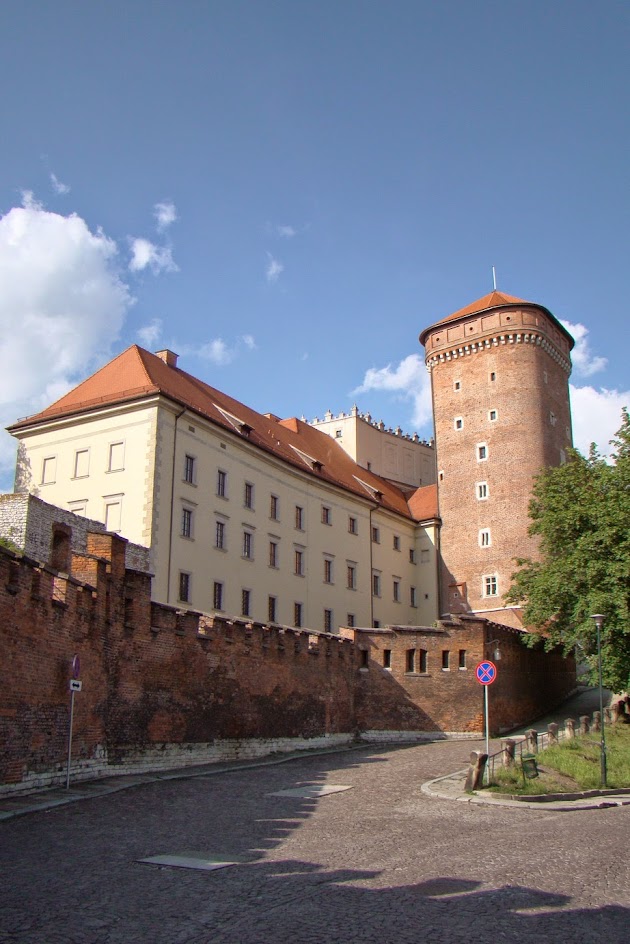Poland. Krakow
Twice during our European travels, we stopped in Krakow, once the capital of Poland and, up until the 18th century, the site of Polish kings' coronations. We walked around the Wawel Royal Castle, saw a copy of the Shroud of Turin in the Franciscan Church, strolled through the central streets of the city to the market square of the Old Town, listened to the trumpeter playing the "Hejnal" - the signal of the exact time from the highest tower of St. Mary's Basilica every hour, tried Chinese food, and also experienced what it feels like to be inside someone’s head...
The first views that Krakow left us with were of the Wawel Hill from the side of the Vistula, the most significant river in Poland...
Our introduction to the city began with a tour of the architectural complex on Wawel Hill. First on the list was the steel sculpture of the Wawel Dragon, who, according to legend, lived in a cave at the foot of the hill during the reign of King Krak (12th century), the founder of Krakow, after whom the city was named. The dragon, again according to legend, was notorious for its gluttony, and if it wasn’t given a sheep once a week, it would swallow people whole... But eventually, the people got fed up, and the brave sons of King Krak decided to trick the dragon by giving it a sheepskin stuffed with sulfur instead... The dragon took it and swallowed it, perhaps being blind or having lost its sense of smell from fear... In the end, the dragon suffocated... But people still remember it with a monument. Perhaps it ate dishonest politicians of that time, which is why they remember it fondly...
The ascent to the castle complex. The Senator's Tower...
The main attraction of the complex is the Cathedral of Saints Stanislaus and Wenceslaus...
The main entrance to the cathedral...
The inner courtyard of Wawel Castle...Next, we strolled through the streets of Krakow...
The Church of Saints Peter and Paul - the first Baroque church in Poland...
The Romanesque Church of Saint Andrew, or Andriy in our language, looked the most photogenic...
The streets are literally saturated with spiritual shrines...
In one of them, namely in the Franciscan Church, there is a copy of the Shroud of Turin - a Christian relic, a four-meter cloth in which, according to tradition, the body of Jesus Christ was wrapped after his crucifixion and death...
The courtyard of the oldest building of the Jagiellonian University, founded in 1364 by King Władysław II Jagiełło, in Krakow...
A cool car in Krakow...
Upon reaching the market square - the main historical part of the city, we saw its main attraction - St. Mary's Basilica, which acquired its modern appearance in 1397...
An interesting "performance" of the basilica is the "Hejnal" - a melodic signal of the exact time, played by a trumpeter every hour from the highest 82-meter tower... The word "hejnal" translates from Hungarian as "morning": previously, this signal also served as a call to wake up...
Waiting for the new hour, we saw the trumpeter in the tower windows that opened... Playing his "signature" melody in all "directions of the world," he waved to the gathered crowd, and with a sense of duty fulfilled, almost like a rock star, he left...
We watched the trumpeter's performance from St. Mary's Square, near the fountain-figure of the "poor student, lost in thought." The name of the fountain is simply touching... What could the poor student be thinking about... Probably, how to pass the session for free...
The Cloth Hall - a building in the center of the market square, inside which there are many souvenir shops...
The clock tower at the foot of which is the most recognizable sculpture in Krakow...
The sculpture is called "Bound Eros" and symbolizes the mad love that makes one lose their head...
The head is empty inside, as always happens under the influence of love charms, so anyone who wants can climb inside...
Moving away from the main square of the city, we approached the fortress wall that once surrounded Krakow...
The only remaining gate of the fortress wall - the Florian Gate, as it was about five centuries ago...
Outside the gates of the "fortress," the next fortification held guard for many years - the Barbican, built in 1498...
A pink piano...
And finally, we had a rather delicious national Polish dish - "Krakow's Chinese food"...






































Comments
Post a Comment